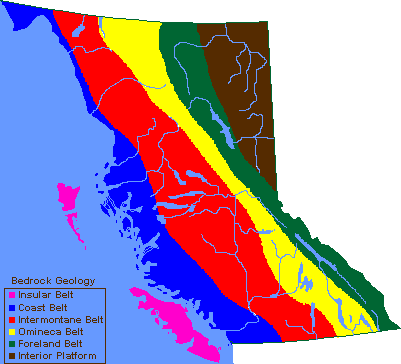
At almost any scale, British Columbia's bedrock geology is a complex mixture of rock types, geological structure, and development sequences. The result is a province that holds rich and diverse mineral resources.
Current Tectonic Theory of the province's geological history maintains that a series of Pacific island arcs were carried north and east on the Pacific Plate. These collided with the westward moving North American Plate, and the island arcs, in sequence, became fused into much of what is now British Columbia. These events are though to have begun 200 - 300 million years ago.
In very general terms, the resulting pattern shows a series of geological belts that is not unlike the Physiographic Regions of the province. The most important consideration to keep in mind when exploring British columbia's geology is to expect the unexpected - sedimentary beds turn up in what was thought to be volcanic and visa versa.
The Insular Belt is composed of sedimentary and volcanic rocks laid down from 50 to 500 million years ago. It is thought they collided with the North American Plate during the Cretaceous era (145 million years ago).
The Coast Belt is made up largely of granites and various metamorphosed sedimentary and volcanic rocks. These were formed between 50 and 200 million years ago and are perhaps thicker that when originally formed. This is possibly due to being compressed between the Insular Belt and the Intermontane Belt.
Between 200 and 300 million years ago, the Intermontane Belt was formed of volcanic and sedimentary rocks. These structures were amalgamated by about 200 million years ago before colliding with the North American Plate to the east.
The Omineca Belt forms the boundary between the ancient North American Plate and the Intermontane Belt. "The intense metamorphism and complex structures of the Omineca belt were produced when a large composite terrane collided with and became accreted to continental crust to the east, probably in Early and Middle Jurassic time". (135 - 160 million years ago)
Much of the Foreland Belt is comprised of sedimentary materials that were deposited on or adjacent to ancestral North America. Folding and faulting has given these rocks spectacular appearance as they were thrust upwards.
The Interior Platform is a series of relatively undeformed sedimentary rocks.
© 1996-
INTERACTIVE BROADCASTING CORPORATION